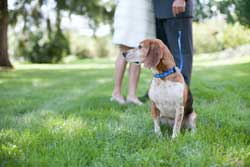Ask the Dermatologist: Yeast
A common concern for pet owners is the recurring presence of yeast. Each pet is unique and what may be a successful treatment for one pet, may have little or no effect on another due to the particular underlying factors, etc.
Holly D. of Utica, KY asks:
What would be a good treatment for yeasts in the paws and on the skin?
There are multiple different options for therapy for Malassezia (yeast) dermatitis. However for localized Malassezia (such as on the paws) topical therapy can be very important. Shampoos containing miconazole or ketoconazole are the more effective shampoo options. There are several good products that you can obtain from your veterinarian that will contain 1% miconazole or 2% ketoconazole. These are important to utilize often as they have little residual activity and only work while in contact with the skin. Other topical leave-on products can also be used. I often utilize a lotion called Resiketochlor (which contains ketoconazole) that can be used and provides residual effectiveness. There are also several different wipes that we utilize from time to time which contain ingredients that leave behind some anti-yeast properties.
For generalized Malassezia infections, oral antifungal therapy is important. Ketoconazole is used most commonly although there are other antifungals (fluconazole, itraconazole) that are occasionally used. These should be used with caution and only
prescribed by your veterinarians because they can interact with some medications and also have some potential risk for undesirable side effects, although that is very uncommon when used appropriately.
The most important aspect in ongoing yeast infections, is to determine the underlying cause for yeast infections. Without addressing the triggers, recurrent yeast infections are common and the best long- term control cannot be achieved.
Talk to your veterinarian about this situation and get their advice. Good luck and hopefully you will find this information helpful.
Rusty Muse DVM, ACVD
Animal Dermatology Clinic
Tustin, CA
Have a question for our doctors? Please send your question via the Contact Page on our website. Sorry, we cannot provide an answer to a specific ailment which requires a physical examination of your pet.
Pets in Weddings Gaining Popularity

Pets have steadily become cherished friends in American homes, with some on equal status as a family member. Therefore, it is with increasing frequency that dogs have been appearing in marriage ceremonies accompanying the couple as all three (sometimes, more) become one household.
A quick search on the internet of “dogs in weddings” returned 63 million results. 63 MILLION! (Not to be outdone, “cats in weddings” had 44 million results). It seems that the saying “Love me, love my dog”, is being taken quite seriously.
Dogs have been featured as ring bearers, walking the bride down the aisle and alongside the couple as vows are exchanged. But even the best plans can be undone when dealing with a dog that might be a tad uncomfortable with a large gathering and all eyes upon him or her.
The New York Times wrote of a man who brought his white German Shepherd as honorary bridesmaid to the wedding, when just prior to the start of the ceremony he spied her getting ready to relieve herself. He ran to her, scooped her up and took her outside until matters were settled to return to a round of applause from the waiting guests.
Other humorous stories documented included the dog that snatched the bride’s tossed bouquet and dogs dancing with guests at the reception. Another story involved a dog facing a “no dogs allowed” policy, so a friend of the bride and groom placed a jacket on the dog, slipped him into the church and sat quietly on the pew as he watched the nuptials.
So don’t be surprised to see a four-legged friend at the next wedding you attend. Or if you see a chicken. Yes, a chicken. But that’s a story for another issue.
Photo: dreamstime/Carisak
